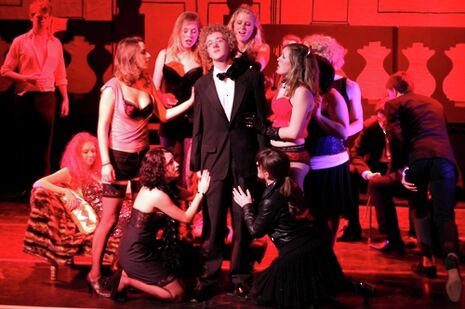Classical: The Rake’s Progress

The Rake’s Progress tells the tale of Tom Rakewell (Gwilym Bowen), an idle youth hopelessly smitten with his wide-eyed sweetheart, Anne Trulove (Joanna Songi). Enter Nick Shadow (Christopher Dollins), a smooth-talking stranger with a devilish grimace, who promises Tom a fortune bestowed upon him by an unknown uncle. Whisked away to London, Tom succumbs to a series of fame-seeking and money-making scams, including a bizarre marriage to bearded celebrity Baba the Turk (Joanna Harries). To cap it all, Nick demands Tom’s soul. Tom dices with the devil (literally) in a game of cards, and is miraculously triumphant, but is quickly rendered insane as a parting gift from Nick. The opera reveals its heartbreaking undertones as we see Tom, consigned to Bedlam, in Anne’s forgiving arms for the last time.
This production featured some uncannily accurate casting. Bowen performed the role of loveable tool with real sincerity, and his reported chest infection strangely seemed to enhance the character’s decline. Songi, past master in the role of innocent maiden, moved audience members to tears with her final lullaby. Perhaps most at home in their roles, however, were Dollins, whose suave vocal tone and villainous grin seemed to come all too naturally, and Harries, who brought the house down, not so much with her fetching facial hair as with her spot-on comic timing. Strong supporting roles included Father Trulove (George Dye) and Sellem the auctioneer (Matthew Sandy), whilst the chorus, drawn from Cambridge’s choirs, relished the opportunity to swap their chapel robes for lingerie and rakish suits. Though their brothel scene performances ranged from slightly awkward to almost too keen, the chorus was on top vocal form.
Conductor Christopher Stark is to be commended for his style: precise, assured, and refreshingly unpretentious. The orchestra tackled the challenging score with skill, but several shaky moments meant that the music lacked the punch which it desperately required. Occasionally the same was true of the singing: rhythmic vitality and crisp diction were vital, yet sadly not always present. The final scene between Anne and Tom could have been even more poignant had the chorus of Bedlam patients toned down their manic hair-brushing and duvet-clad pacing in order to spotlight the couple.
Nonetheless, credit must go to director Claudia Parkes for a production which held together across multiple changes of register, and a set design which contrasted simplicity with opulence. This was a smart choice of opera for a student production. Stravinsky plus Auden means witty English text with an alluring Russian musical accent. Its neoclassical style provides light accessible music with extra kicks. It is both funny and sad, off-the-wall yet not impossibly abstract. Unlike Tom Rakewell, this production resisted the temptation of style over substance, and showcased some pretty promising talent.
 Comment / Plastic pubs: the problem with Cambridge alehouses 5 January 2026
Comment / Plastic pubs: the problem with Cambridge alehouses 5 January 2026 News / Cambridge academics stand out in King’s 2026 Honours List2 January 2026
News / Cambridge academics stand out in King’s 2026 Honours List2 January 2026 News / Cambridge businesses concerned infrastructure delays will hurt growth5 January 2026
News / Cambridge businesses concerned infrastructure delays will hurt growth5 January 2026 News / AstraZeneca sues for £32 million over faulty construction at Cambridge Campus31 December 2025
News / AstraZeneca sues for £32 million over faulty construction at Cambridge Campus31 December 2025 Interviews / You don’t need to peak at Cambridge, says Robin Harding31 December 2025
Interviews / You don’t need to peak at Cambridge, says Robin Harding31 December 2025








